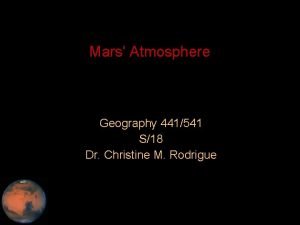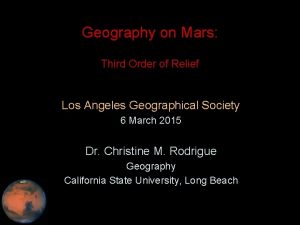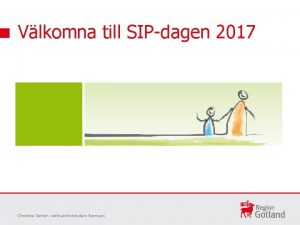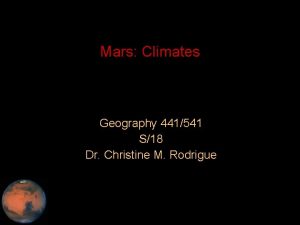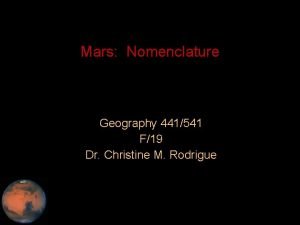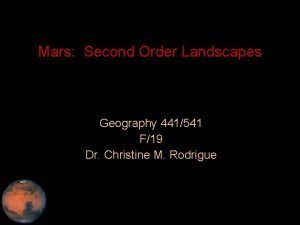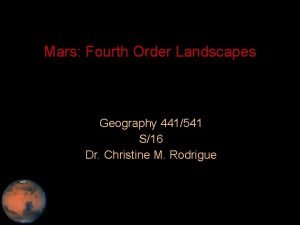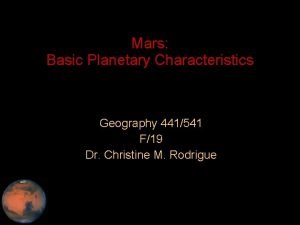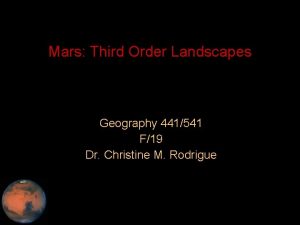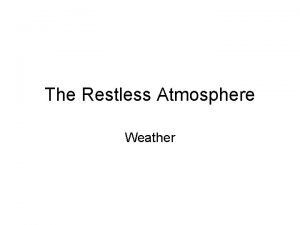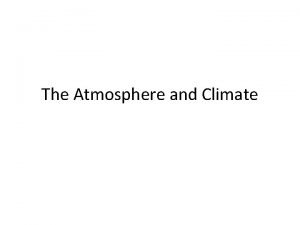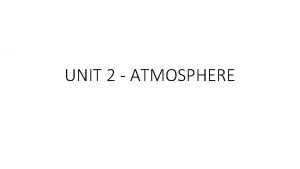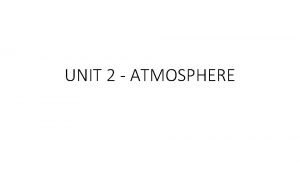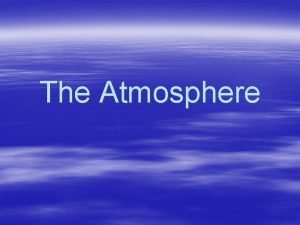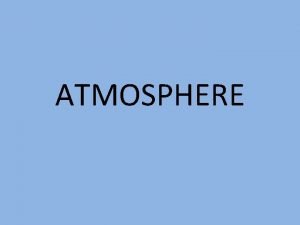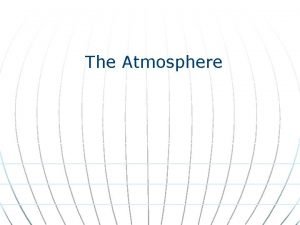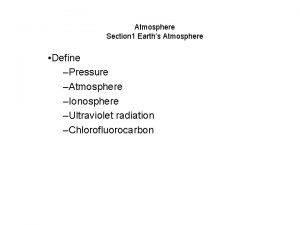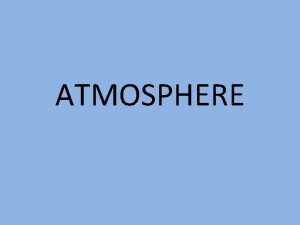Mars Atmosphere Geography 441541 S18 Dr Christine M




























- Slides: 28

Mars' Atmosphere Geography 441/541 S/18 Dr. Christine M. Rodrigue

Mars' Atmosphere • Mars' atmosphere, weather, and climate – Mars' atmosphere: – – Chemical composition and dustiness Vertical temperature and pressure structure Horizontal pressure structure Winds and the global circulation – Martian weather: – Seasonality – Storms – Mars climate: – Geochemical cycles and weather – Climate zones – Climate change

Mars' Atmosphere • Atmospheric gas composition: – Earth dominated by – – Molecular nitrogen (78%) Molecular oxygen (21%) Variable amounts of water Trace amounts of carbon dioxide (0. 04%), argon (0. 93%), various others – Mars dominated by – – Carbon dioxide (95%) Molecular nitrogen (2. 7%) Argon (1. 6%) Trace amounts of oxygen, carbon monoxide, water vapor, hydrogen

Mars' Atmosphere • Atmospheric density (p) and altitude (A): – Declines with altitude, as on Earth – – Less atmosphere above compressing air Mars lapse is less steep than Earth's p = 0. 699 * e -0. 00009 * A (Mars) vs. p = 101. 325 * e -0. 00012 * A (Earth) p (k. Pa); A (m)

Mars' Atmosphere • Vertical temperature structure – Temperature behavior with altitude defines bands, as on Earth – Less atmosphere above compressing air

Mars' Atmosphere • Hadley cell: – O 2 & NO glow – 1. 27 μm emission (NIR) – ESA MEX OMEGA

Mars' Atmosphere • Spatial variations in air pressure: – Hadley circulation: temperature + Coriolis force (Wikipedia image)

Mars' Atmosphere • Spatial variations in air pressure: – Hadley circulation: temperature + Coriolis force – – Uplift at equator → low pressure Air subsides ~45° → higher pressure Like Earth around equinoces: 2 cells Unlike Earth around solstices: 1 big cell

Mars' Atmosphere • Spatial variations in air pressure: – Hadley circulation: temperature + Coriolis force – – Uplift at equator → low pressure Air subsides ~45° → higher pressure Like Earth around equinoces: 2 cells Unlike Earth around solstices: 1 big cell

Mars' Atmosphere • Spatial variations in air pressure: – Hadley circulation: temperature + Coriolis force – Equinox and solstice

Martian Weather • Temporal variations: Polar cyclones: – Resemble Earth polar hurricanes – Earth to right, Mars below

Martian Weather • Temporal variations: Air pressure changes – Diurnal patterns (Pathfinder) – Midday spike, sundown pit – Note odd peak around midnight and "wee hours" drop – Complex secondary pattern, with as many as 4 pits and peaks

Martian Weather • Temporal variations: Air pressure changes – Diurnal patterns – MRO Climate Sounder confirmed Pathfinder data – Found it is global – More pronounced away from equator – Thermal tide creates lows under late afternoon sun

Martian Weather • Temporal variations: Air pressure changes – Diurnal patterns (LMST=Local Mean Solar Time) – Thermal tide inverse relationship to pressure tide – These create local winds

Martian Weather • Temporal variations: Air pressure changes – Seasonal patterns – Annual cycles of pressure changes – Huge increase as South Polar ice cap sublimes and starts moving to North Pole – Reverse blip from smaller North Pole effect

Mars' Climates • Temporal variations: Length of seasons – Unequal (Earth's close to equal in length) – Mars' greater eccentricity

Mars' Climates • Temporal variations: Telling time on Mars – Way to keep track of seasons on Mars: Solar longitude) – Starts at Spring Equinox – Northern Hemisphere

Mars' Climates • Temporal variations: Thermal inertia – Some materials heat up/cool down quickly (like land surfaces on Earth) – Low specific heat/thermal inertia – This affects diurnal and seasonal temperature contrasts, pressure differences, and winds/breezes: land-sea breezes, monsoons – On Mars, high albedo regions (dusty) have low thermal inertia and function like "continents" or inland areas on Earth – Others heat up/cool slowly (like ocean/lake surfaces on Earth) – High specific heat/thermal inertia – On Mars, low albedo surfaces tend to have high thermal inertia and function like "water bodies" on Earth climatologically

Mars' Climates • Temporal variations in pressure and wind and spatial variations in albedo

Mars' Climates • Temporal variations in global circulation: S. summer

Mars' Climates • Temporal variations in global circulation: morning at SL 0°

Mars' Climates • Temporal variations in global circulation: afternoon at SL 0°

Mars' Climates • Temporal variations in global circulation: evening at SL 0°

Mars' Climates • Cloudiness: – Carbon dioxide and water vapor – Pathfinder below – Phoenix to right

Mars' Climates • Storms: – Dust storms (Hubble) and dust devils – (Spirit in Gusev Crater)

Mars' Climate Change • Polar ice cap accelerated sublimation

Mars' Climates • Water and nitrogen cycle: – Triple point – 15 N vs. 14 N ratio high – Mars lost 90% of its N – Imagining it all back in the atmosphere, we get air pressure ~78 h. Pa – That would have allowed liquid water – Similarly, deuterium to hydrogen ratio high, ~7 -8 x as high as Earth's – Mars must have lost 6. 5 times as much water as there is in the modern ice caps!

Mars' Climates • Argon: – Change in isotope ratios found by MAVEN – 38 Ar vs. 36 Ar ratio high – The lighter isotope is more easily sputtered off at the top of the atmosphere than the heavier isotope – Mars lost 65% of its Ar – Reïnforces magnitude of atmospheric loss the way N and H isotopes do
 Sae s18
Sae s18 Mars atmosphere
Mars atmosphere Geography of mars
Geography of mars Frq format ap human geography
Frq format ap human geography 5 themes of geography ap human geography
5 themes of geography ap human geography Ap human geography political geography test
Ap human geography political geography test Christine mooshammer
Christine mooshammer Christine trahms
Christine trahms Christine wijshake
Christine wijshake Christine senter
Christine senter What is the historical significance
What is the historical significance Christine nöstlinger werke
Christine nöstlinger werke Christine e lynn
Christine e lynn Christine pfund
Christine pfund Slope
Slope Dr christine anne gallagher
Dr christine anne gallagher Christine chang md
Christine chang md Christine kourkoumelis
Christine kourkoumelis Christine branche
Christine branche Christine korsgaard
Christine korsgaard Christine staiger
Christine staiger Christine swenson
Christine swenson Christine katlama
Christine katlama Christine noelle
Christine noelle Christine mbo.a
Christine mbo.a Christine katlama
Christine katlama Angelo buono 2000
Angelo buono 2000 Christine köhler-azara
Christine köhler-azara Christine rongey
Christine rongey

